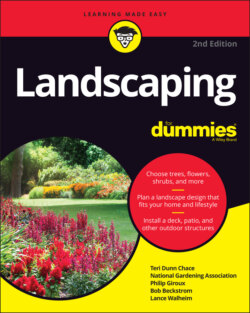Читать книгу Landscaping For Dummies - Lance Walheim - Страница 44
Focusing on Repetition in Your Design
ОглавлениеRepetition of hardscape materials — including brick, wood, stone, concrete, wood chips, and fencing — is a simple way to make your garden look like it’s all one piece, even if the areas are distinctly different. The following can make your landscaping design cohesive:
Select your hardscape materials to match your garden style and repeat them throughout the landscape. Manmade materials — basically, anything other than plants — carry great weight in the landscape, because they draw viewers’ eyes like a magnet.For example, you can use a single section of diagonal, framed lattice to support a climbing rose along the wall of your house; an L-shaped couple of sections to shield the compost pile from view; or three or four linked sections to serve as a privacy screen along the patio. Depending on how large your yard is, you can repeat the lattice theme in variation by installing solid, vertical-board privacy fence topped by a narrow strip of lattice. (Want a rustic look? Substitute bent-wood or plain lumber. Want a more formal look? Use cast iron and similar-looking materials. You get the idea … .)
Stick in the same plants here and there. (Think, “Here a shrub, there a shrub.”) Repeat backbone plants that perform well most of the year, like evergreens (see Chapter 11), groundcovers (refer to Chapter 16), and shrubs (check out Chapter 12), to tie your garden areas to each other.
Repeat shapes to pull things together. Consider curved outlines of beds, undulating paths, shapely urns, and mounds of plants. At the other end of the spectrum, try no-nonsense point A to point B paths, yardstick-straight bed edges, spiky plant forms, clipped hedges, and vertical board fences.
Use colors again and again. By repeating colors throughout the landscape, you make it look like it’s all one piece — the unity thing again. For example, put in clumps of yellow flowers here and there in various beds, pots, or plantings across your back yard, and you’ll find your eye travels from one patch of yellow to the next in a seamless, satisfying way. But if the most eye-catching plant in one bed is red, the next one yellow, the next one white, your poor eyes get confused.Combine colors of plants with colors of your house or hardscape, too, for unity’s sake. For instance, paint a lattice cobalt blue and match it with big folk-art blue-and-yellow flower pots, and you can use that two-tone color scheme to run through the garden.
Don’t overdo or become overzealous with repetition, however. A little goes a long way!
